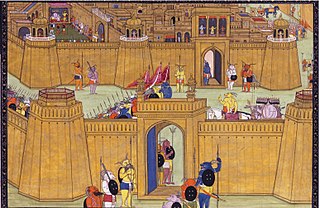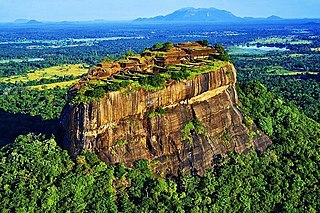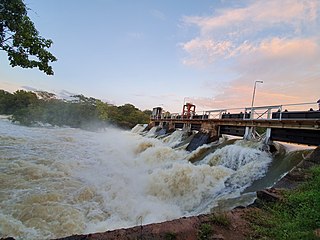
Lanka is the name given in Hindu epics to the island fortress capital of the legendary asura king Ravana in the epics of the Ramayana and the Mahabharata. The fortress was situated on a plateau between three mountain peaks known as the Trikuta Mountains. The ancient city of Lankapura is said to have been burnt down by Hanuman. After its king, Ravana was killed by Rama with the help of Ravana's brother Vibhishana, the latter was crowned king of Lankapura. His descendants were said to still rule the kingdom during the period of the Pandavas. According to the Mahabharata, the Pandava Sahadeva visited this kingdom during his southern military campaign for the rajasuya of Yudhishthira. The palaces of Ravana were said to be guarded by four-tusked elephants.

Patricide is the act of killing one's own father or stepfather. The word patricide derives from the Latin word pater (father) and the suffix -cida. Patricide is a sub-form of parricide, which is defined as an act of killing a close relative. In many cultures and religions patricide was considered one of the worst sins. For example, according to Marcus Tullius Cicero, in the Roman Republic it was the only crime for which the civilian could be sentenced to death.

Mahāvaṃsa (Sinhala: මහාවංශ, Pali: මහාවංස is the meticulously kept historical chronicle of Sri Lanka until the period of Mahasena of Anuradhapura. It was written in the style of an epic poem written in the Pali language. It relates the history of Sri Lanka from its legendary beginnings up to the reign of Mahasena of Anuradhapura covering the period between the arrival of Prince Vijaya from India in 543 BCE to his reign and later updated by different writers. It was first composed by a Buddhist monk at the Mahavihara temple in Anuradhapura in the 5th century CE.

Sigiriya or Sinhagiri is an ancient rock fortress located in the northern Matale District near the town of Dambulla in the Central Province, Sri Lanka. It is a site of historical and archaeological significance that is dominated by a massive column of granite rock approximately 180 m (590 ft) high.
Queen Anula of Anuradhapura was the first queen regnant in Sri Lankan history, as well as the first documented female head of state in Asia. Anula initially rose to power as consort of King Chore Naga, son of King Valagambahu of Anuradhapura. However, in her five-year reign, she poisoned her way through at least four other husbands and consorts, and she eventually governed Rajarata on her own. She should not be confused with the other famous Anula in Sri Lankan history, king Devanampiyatissa's sister-in-law, the first woman in Sri Lanka to be ordained as a bikkhuni. The primary source for Anula, Queen Regnant of Anuradhapura's reign is the Mahavamsa, chapters 34 and 35.
Vikramabahu was a medieval king of Sri Lanka. Following the death of his father in 1029, Vikramabahu led the resistance movement against the Chola invaders of the country, ruling from the southern principality of Ruhuna. He spent a number of years building up his forces to drive out the Chola, but died before he could launch his military campaign.

Vijayabahu I, also known as Vijayabahu the Great, was a medieval king of Sri Lanka. Born to a royal bloodline, Vijayabahu grew up under Chola occupation. He assumed rulership of the Ruhuna principality in the southern parts of the country in 1055. Following a seventeen-year-long campaign, he successfully drove the Cholas out of the island in 1070, reuniting the country for the first time in over a century. During his reign, he re-established Buddhism in Sri Lanka and repaired much of the damage caused to infrastructure during the wars. He offered the Thihoshin Pagoda(Lord of Sri Lanka Buddha image) to Burma king Alaungsithu and it is now still in Pakokku.
The God King is a 1974 British–Sri Lankan historical film directed by Lester James Peries. The film is based on the historical clash between brothers Kasyapa and Moggalana on Sigiriya Rock.

Kala Wewa built by the King Datusena in 460 A.D, is a twin reservoir complex which has a capacity of 123 million cubic meters. This reservoir complex has facilitated with a stone made spillway and three main sluices. From the central major sluice, a 40 feet wide central conveys water to feed thousands of acres of paddy lands and ends at the historical capital Anuradhapura city tank Tissa Wewa meandering over 87 km (54 mi) at a slope of 6 inches per mile and is another wonder of primeval hydraulic engineering facility in ancient Ceylon.
Dhatusena was a king of Sri Lanka who reigned from 455 to 473 AD. He was the first king of the Moriyan dynasty. In some records, he is also identified as Dasenkeli. Dhatusena reunited the country under his rule after twenty six years of anarchy, defeating the six Dravidians that were ruling the country at that time. Dhatusena built large reservoirs and canals to augment the agriculture in the country.

Anuradhapura Kingdom, named for its capital city, was the first established kingdom in ancient Sri Lanka related to the Sinhalese people. According to the Mahāvaṃsa, it was founded by King Pandukabhaya in 437 BC, whose authority extended throughout the country.

The Anuradhapura period was a period in the history of Sri Lanka of the Anuradhapura Kingdom from 377 BCE to 1017 CE. The period begins when Pandukabhaya, King of Upatissa Nuwara moved the administration to Anuradhapura, becoming the kingdom's first monarch. Anuradhapura is heralded as an ancient cosmopolitan citadel with diverse populations.
The Five Dravidian were five Tamil Chiefs apparently from the Pandyan Dynasty who ruled the Anuradhapura Kingdom for 14 years from 103 BC to 88 BC.

The Chola conquest and occupation of Anuradhapura Kingdom was a military invasion of the Kingdom of Anuradhapura by the Chola Empire. It can be seen as an ensuing conflict between Chola and Sinhalese kings after the initial conflict between Chola and the Pandya-Sinhalese alliance during conquest of the Pandya Kingdom by Chola king Paranthka I. After the defeat, Pandya king Rajasimha took his crown and the other regalia and sought refuge in Anuradhapura. The Paranthka made several futile attempts to regain regalia, including invasion of Sri Lanka on a date between 947 and 949 CE during the reign of Sinhalese king Udaya IV. Therefore, one of the driving motives behind the invasions of Anuradhapura by the Cholas' was their desire to possess these royal treasures. The conquest started with the invasion of the Anuradhapura Kingdom in 993 CE by Rajaraja I when he sent a large Chola army to conquer the kingdom and absorb it into the Chola Empire. Most of the island was subsequently conquered by 1017 CE and incorporated as a province of the vast Chola empire during the reign of his son Rajendra Chola I. The Chola occupation would be overthrown in 1070 CE through a campaign of Sinhalese Resistance led by Prince Kitti, a Sinhalese royal. The Cholas fought many subsequent wars and attempted to reconquer the Sinhalese kingdom as the Sinhalese were allies of their arch-enemies, the Pandyas. The period of Chola entrenchment in northern Sri Lanka lasted in total about three-quarters of a century, from roughly 993 CE to 1070 CE, when Vijayabahu I recaptured the north and expelled the Chola forces restoring Sinhalese sovereignty.

Rajarata [rā dja ra tə] was one of three historical regions of the island of Sri Lanka for about 1,700 years from the 6th century BCE to the early 13th century CE. Several ancient cities, including Tambapanni, Upatissa Nuwara, Anuradhapura and Polonnaruwa, were established as capitals within the area by successive rulers. Rajarata was under the direct administration of the King. Two other areas, Malayarata and Ruhunurata, were ruled by the king's brothers "Mapa" and "Epa". The Magha invasion in the 13th century brought about the end of the Rajarata kingdom.
Moggallāna I was King of Anuradhapura in the 6th century, whose reign lasted from 497 to 515. After defeating his brother Kashyapa I in a civil war, he replaced Kashyapa as King of Anuradhapura, and was succeeded by his son Kumara Dhatusena.
Kumara Dhatusena was King of Anuradhapura in the 6th century, whose reign lasted from 515 to 524. He succeeded his father Moggallana I as King of Anuradhapura and was succeeded by his son Kittisena.

The Sinhalese monarchy has its origins in the settlement of North Indian Indo-Aryan immigrants to the island of Sri Lanka. The Landing of Vijay as described in the traditional chronicles of the island, the Dipavamsa, Mahavamsa and Culavamsa, and later chronicles, recount the date of the establishment of the first Sinhala Kingdom in 543 BC when Prince Vijaya, an Indian Prince, and 700 of his followers are claimed to have landed on the island of Sri Lanka and established the Kingdom of Tambapanni. In Sinhalese mythology, Prince Vijaya and followers are told to be the progenitors of the Sinhalese people. However according to the story in the Divyavadana, the immigrants were probably not led by a scion of a royal house in India, as told in the romantic legend, but rather may have been groups of adventurous and pioneering merchants exploring new lands.

Pidurangala Vihara is an ancient Buddhist temple situated in Pidurangala village of Matale District, Sri Lanka. The temple was constructed on a massive rock called Pidurangala, which is located a few kilometers north of the historical fort Sigiriya.

Nachchaduwa wewa is a reservoir near Thammannakulama, Sri Lanka. The reservoir is used to store water brings from Kala Wewa through Yoda Ela channel. The reservoir was severely damaged in 1957 flood and the restoration of the tank was completed in 1958.













